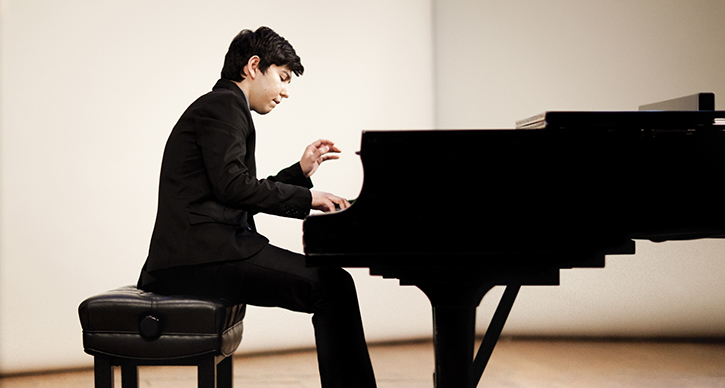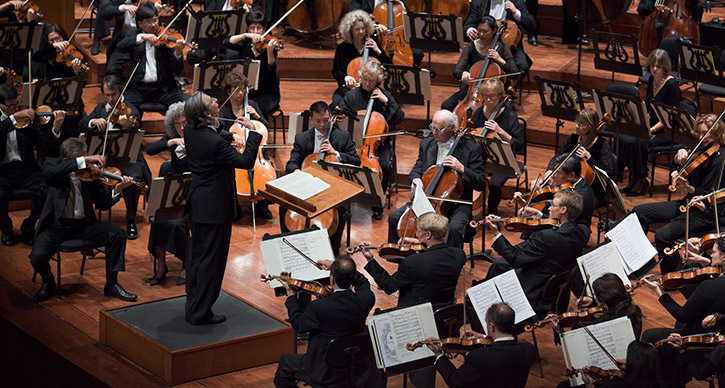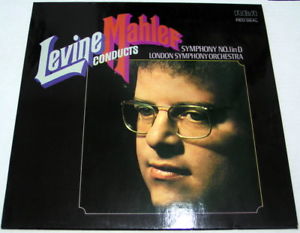Prokofiev, Shostakovich, and the Year 1936

Pianist Behzod Abduraimov, who’ll perform with the Mariinsky Orchestra on January 24, 2015. The program features works by Prokofiev and Shostakovich. Photo by Ben Ealovega.
1936 was a portentous and dramatic year in the lives of Sergei Prokofiev and Dimitri Shostakovich. That summer, Prokofiev would move his family and career from Paris back to the Soviet Union under the impression that he would be able to compose relatively freely and continue touring abroad. However, when Prokofiev arrived in Moscow, his passport was confiscated. He was trapped. Meanwhile, in January of 1936, Shostakovich became a target of state-guided criticism and censorship. After rising to stardom in 1935, Shostakovich’s future as a composer was suddenly in jeopardy.
Prokofiev and Russia’s greatest expatriate composer
Prokofiev’s 1921 Piano Concerto No. 3, to be performed by the Mariinsky Orchestra on January 24, 2015 at Hill Auditorium, in many ways, symbolizes the brilliant career that he unwittingly relinquished when he returned home in 1936. Premiered by the Chicago Symphony Orchestra three years after Prokofiev’s original emigration from Russia, the work did not garner much attention for another year, when renowned conductor Serge Koussevitsky presented the piece in Paris. Prokofiev even performed alongside the London Symphony Orchestra when the concerto was first recorded in 1932.
The Piano Concerto No. 3 remains one of Prokofiev’s most popular works, and represents the composer’s appropriation and manipulation of Romantic styles and forms. Typical of Prokofiev’s piano music, the soloist’s part is impressively virtuosic and bumptious, particularly during the concerto’s rousing finale. The work’s three movements follow a traditional slow-fast-slow scheme, but its overall content is slightly more dissonant than Prokofiev’s later works, as he did not start to seek a simpler style until the mid-1930s.
Excerpt from Prokofiev’s Piano Concerto No. 3 performed by Mariinsky Orchestra. Courtesy of Mariinsky Label. Catalog also available via iTunes.
Although Prokofiev was already well known in the West in 1921, the Piano Concerto no. 3 certainly contributed to the international success he enjoyed from 1918-1936. When Prokofiev returned to Moscow, he did so believing his career would continue as it had. Exactly why Prokofiev left Paris is unknown, but one theory involves Shostakovich’s fall from grace. Despite Prokofiev’s fame in Europe and America, he had to compete with Rachmaninov and Stravinsky for the title of Russia’s greatest expatriate composer. Seeing that Shostakovich’s career might be over, Prokofiev may have thought he could return to Russia without a rival, and enjoy the national celebrity all to himself.
“At the same time Prokofiev returned to Russia a hero, Shostakovich’s career began to fall apart.”
Shostakovich’s challenges began less than a month into 1936, when, on January 28, the newspaper Pravda published a state-directed condemnation of his hugely successfully opera Lady Macbeth of the Mtsensk District entitled “Chaos Instead of Music.” The work had received 177 performances in Moscow and Leningrad in two years, but was suddenly derided by the mouthpiece of the Soviet state. Two similar articles hit newsstands in the following months, each criticizing Shostakovich’s music on the grounds that it violated Stalin’s cultural paradigm of “social realism.” At the same time Prokofiev returned to Russia a hero, Shostakovich’s career began to fall apart.
Shostakovich’s Symphony No. 4 immediately suffered from this new government criticism. Coming off the high of Lady Macbeth of the Mtsensk District, Shostakovich was halfway finished with the work when “Chaos Instead of Music” was published. Given Shostakovich’s new public circumstances, his friends and colleagues urged him to placate Pravda with the new symphony, which Shostakovich refused to do. He arranged a premiere performance with the Leningrad Philharmonic Orchestra for December 1936, but it was cancelled under ambiguous circumstances. The Symphony No. 4 did not receive it first performance until 1961, when the Soviet cultural ministry finally relaxed its expectations for Shostakovich and other Russian artists.
Excerpt from Shostakovich’s Symphony No. 4 performed by Mariinsky Orchestra. Courtesy of Mariinsky Label. Catalog also available via iTunes.
Unlike Shostakovich’s previous two symphonies, Symphony No. 4 (which is also part of the Mariinsky Orchestra’s program this January), does not feature vocalists, but rather relies on a large orchestra. It is an enormous, hour-long work that is filled with subtle suggestions of Mahler, whose music Shostakovich studied enthusiastically. The symphony’s form is unusual in its three movements of drastically imbalanced lengths. Almost bizarrely, the symphony’s outer movements are both over twenty minutes long and the inner movement lasts less than ten. However, in listening, the piece seems fairly continuous, and exhibits embryonic forms of the distinct musical characteristics Shostakovich would develop over the rest of his career.
Although Shostakovich’s Fourth Symphony was buried by the controversies of 1936, he rebounded quickly. The next year, Shostakovich premiered his landmark Symphony No. 5, which redeemed himself both with audiences and Soviet leadership. At the same time, Prokofiev was struggling with the unexpected realities of his new life in Russia. Not only was his passport terminated upon his return to the country, but he met much more resistance from the cultural ministry than he had anticipated.
For the remainder of Prokofiev and Shostakovich’s time as contemporaries, their careers were very much alike. Despite their differences, Prokofiev and Shostakovich shared in the classic dilemma of Soviet-era composers: the struggle to simultaneously satisfy one’s artistic desires and the desires of state.
Interested in learning more? Explore the Mariinsky Orchestra’s history in Ann Arbor through our archives.
UMS Playlist: Classical Music Old Friends from Communications Director Sara Billmann
This post is a part of a series of playlists curated by UMS staff, artists, and community. Check out more music here.

Photo: San Francisco Symphony, who’ll perform Mahler Symphony No. 7 at Hill Auditorium on November 13, 2014.
I grew up in a small town in Wisconsin and studied piano from age 5 and oboe from age 11 in a family where music was central. My mother was a piano teacher, taught vocal music in the public schools, and directed her church choir; my sister became a professional horn player and freelances in New York; and even my father, a middle school math teacher for over 35 years, participated by periodically singing in a local chorus and playing the baritone in a local German band.
Because of that background, I was constantly exposed to classical music, but there are some pieces that stand out as having made an incredible impression on me as a young musician from the time of middle school until early college. While my tastes have certainly evolved over the years, these are still my “old friends” that I love to revisit and never grow tired of.
Mahler’s Symphony No. 1: I fell in love with this piece in 7th or 8th grade and can remember being home alone, turning out all of the lights, and lighting candles to listen to an early James Levine recording in a complete solitude. Mahler could take me to a place of incredible peace, only to be interrupted by the bombastic beginning to the fourth movement, which always scared the bejeezus out of me. To this day, I’m still a pushover for Mahler and the emotional range that his symphonic and vocal works explore.
Bach Brandenburg Concerto No. 2: As an oboe player, I loved playing along with the record of Bach’s Brandenburg Concerto No. 2. It’s such a joyful piece, fun to play, but also fun to listen to. My sister would occasionally play along with me, adapting the trumpet part for horn.
Beethoven Symphony No. 9: I played this work in high school with my local orchestra (with my sister also in the orchestra and my dad in the chorus). Being immersed in the sound of full orchestra plus chorus all on one stage was a remarkable experience for a young musician.
Tchaikovsky’s Capriccio Italien: While seemingly not performed very often these days, this is one of the first classical music pieces that I can remember falling in love with, probably in about 5th or 6th grade. If I remember correctly, we had an LP that included Capriccio Italien, Marche Slave, and 1812 Overture, but it was always Capriccio Italien that I returned to time and again.
Dvorák’s “New World” Symphony: Dvorák’s works are readily accessible and easy to listen to, but certainly not “easy listening.” A recent New York Times article talked about how Dvorák ended up in Iowa, where he wrote this symphony.
Schubert: When I left Wisconsin to move to Ann Arbor to attend the University of Michigan, my sister (then a senior at the University of Wisconsin) made a couple of cassette tapes for me of some of her favorite pieces by Schubert, which I listened to constantly for several years. Among the highlights: Dietrich Fischer-Dieskau singing Die schöne Müllerin, the “Trout” Quintet and the Rondo in D Major for piano duo. Sadly, her tape ran out in the middle of the work, and it was years before I heard how it ended.
Shostakovich: Michael Gowing, the former UMS ticket office manager who retired over a decade ago, considered Shostakovich a “B movie composer,” but I always loved his works. While in college here at U-M, I heard Mariss Jansons conduct the Oslo Philharmonic in Shostakovich’s Symphony No. 7 with its Bolero-like theme, and it was an extraordinary event that began a lifelong appreciation for Shostakovich’s works. I still love listening to the string quartets (especially Nos. 7, 8, and 15), his piano quintet, and many of the symphonies. The Kirov Orchestra’s performance of his Symphony No. 13 several years ago left me in tears, completely shaken at the power of music.
Listen to various selections and recordings of Sara’s picks on Spotify:
What did you think about this playlist? Share your thoughts or song suggestions in the comments below.



